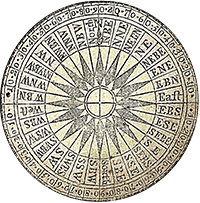Here is a fantastic tale of a once captive girl who became a well respected member of the Miami Tribe. It is the story of Frances Slocum.
In the summer of 1777 Jonathan Slocum, with his wife and nine children, and accompanied by his father-in-law, Isaac Tripp, removed from Rhode Island to Pennsylvania and settled in the beautiful Wyoming valley, not far from Wilkes-Barre. The members of the family were Quakers, who treated the Indians with great kindness, and in the great massacre of July 3, 1778, they were not molested. It happened, however, that Giles Slocum, Jonathan’s eldest son, fought against the Indians on that occasion, and when this became known to the savages, they resolved to be avenged.
On November 2, 1778, three Delaware Indians stealthily approached the Slocum dwelling, which stood in the edge of a piece of timber. Some time before this Nathan Kingsley, a neighbor, had been captured by the Indians and his wife and two sons were staying with the Slocums. The men were away from home, but the two Kingsley boys were engaged in sharpening a knife on a grindstone which stood near the door. The elder boy, a lad some fourteen years of age, wore a soldier’s coat, which it is supposed angered the Indians, as one of them quickly leveled his gun and shot the boy dead.
Alarmed by the report of the gun, Mrs. Slocum rushed to the door and saw the Indian scalping the Kingsley boy with the knife he had been grinding. With some of her children she fled to the woods, while her daughter, Mary, about ten years old, carried Joseph, the youngest of the family. Little Frances, five years of age, and a lame brother. Ebenezer, concealed themselves under the stairway.
After the Indians had ransacked the house and were about to depart, one of them chanced to notice the little girl’s feet protruding from beneath the stairway. She and her brother were dragged from their hiding place, and with the two children and the surviving Kingsley boy the Indians started for the woods, hoping to make their escape before an alarm could reach the Wilkes-Barre fort, which was but a short distance away.
When Mrs. Slocum saw the Indians carrying away her children, the mother love triumphed over fear and she came forth from her place of concealment in the underbrush to plead for her little ones. The savages seemed to enjoy her distress and showed no intention of releasing either of the children until the frantic mother pointed to the boy’s feet and exclaimed: “See, the child is lame; he can do thee no good!” The Indian let go of Ebenezer, but seized little Frances, threw her over his shoulder and, with his two companions, hurried toward the timber.
The last sight the grief-stricken mother ever had of her daughter was the tear stained face looking back over the shoulder of her captor, one hand brushing away the auburn curls from her eyes and the other outstretched toward her mother, the childish voice calling “mamma! mamma!” until its echoes were lost in the forest.
It was not until the close of the Revolutionary war that any systematic search was begun for the missing child. In 1784 two brothers of Frances went to Niagara and made inquiry for their sister, offering a reward of one hundred guineas for information that would lead to her recovery. They thought this sum would tempt some Indian who knew of her whereabouts to tell where she could be found, but they were compelled to return home without any tidings of their lost sister.
In 1788 the two brothers again made an effort to learn something of the fate of Frances. They made an extended trip into the interior of Ohio, where they secured the sympathy and cooperation of Indian agents and traders and spent several months in visiting Indian villages in the hope of finding some one who could tell them what had become of their little sister. They offered a reward of $500 for any information, but in the end were forced to return home without having obtained the slightest clue.
Still the mother would not relinquish the thought that her child was still alive. Mrs. Slocum died on May 6, 1807, aged seventy-one years, but almost with her last breath she asserted the belief that Frances was still living and enjoined her children to continue the quest for their lost sister.
In the meantime, Frances was treated with the utmost kindness by the Indians. Her red hair made her almost an object of veneration among them. Soon after this she was turned over to Tuck Horse and his wife, and adopted her as his daughter to supply the place of one of similar age who had died.
It seems that she did not remain long as a member of this family, as in telling her own story, Frances said: “Early one morning Tuck Horse came and took me, and dressed my hair in the Indian way, and then painted my face and skin. He then dressed me in beautiful wampum beads, and made me look, as I thought, very fine. I was much pleased with the beautiful wampum. We then lived on a hill, and I remember he took me by the hand and led me down to the river side to a house where lived an old man and woman. They had once several children, but now they were all gone—either killed in battle, or having died very young.
When the Indians thus lose their children they often adopt some child as their own, and treat it in all respects like their own. This is the reason why they so often carry away the children of the white people. I was brought to these old people to have them adopt me if they would. They gave me the name of We-let-a-wash, which was the name of their youngest child, whom they had lately buried.”

Then she became the wife of She-po-con-ah, a Miami chief, commonly called Deaf Man, and by this marriage she became the mother of two sons and two daughters. The two sons died in childhood, but the daughters both grew to maturity and married.
Upon this marriage, Frances became a Miami and took the name of Ma-con-a-quah, which means “a young female bear.”
Late in the year 1834, or early in the year 1835, Colonel George W. Ewing, an Indian trader, of Logansport, who had a large trade with the Miamis, stopped for the night at the Deaf Man’s village, situated on the Mississinewa river a few miles above its mouth. He was given the hospitality of an Indian home, the mistress of which was a respectable Indian woman, and during the evening he noticed that her children and grandchildren treated her with great respect and obedience.
Ewing retired soon after eating his supper to a bed of skins and blankets that had been prepared for him in one corner of the cabin. But he did not go to sleep. All the members of the family soon after disappeared, except the old woman, who occupied herself for a time in attending to some ordinary household duties.
As she moved about the cabin the trader watched her, noticing something peculiarly striking in her appearance, especially her hair, until he began to suspect that this was a white woman. His suspicion was soon afterward confirmed, when one of her arms was accidentally bared and he saw that the skin above the elbow was white. He then began a conversation with her in the Miami tongue—and on gaining her confidence to some extent asked her pointedly if she was not a white woman.
The question apparently startled her and at first she gave an evasive answer. But Colonel Ewing made her understand that he was her friend and she finally told him her story, or what she could remember of her early life. She said she had been carried away from near some town on the Susquehanna river when she was a little girl, that she thought her father’s name was Slocum and that he was a Quaker.
Upon arriving at his home the next day Colonel Ewing told his mother what he had learned. His mother urged him to write to the citizens of that area.
In due time Colonel Ewing’s letter reached the family at Wilkes-Barre. Arrangements were at once commenced for Joseph Slocum to go to the home of his sister, Mrs. Mary Towne, in central Ohio, and with her proceed to Peru, Indiana, while his brother Isaac, who lived near Sandusky, was to join them there as soon as possible. As the distance from Sandusky to the Miami village was much shorter than that which Joseph and Mrs. Towne had to travel, he arrived several days in advance of his brother and sister. His anxiety to meet the sister, who had so long been mourned as lost, was so great that he could not wait for the arrival of his brother and sister.
Accompanied by James T. Miller as interpreter, he repaired to the house of Frances, where he was received with that stolid indifference peculiar to the Indian. She manifested neither pleasure nor surprise at his coming and seemed rather reluctant to tell anything of herself to a stranger.
Before she was captured in her childhood, while she and one of her brothers were playing in the blacksmith shop one day, her brother struck the fore finger of her left hand with a hammer and inflicted such an injury that the nail was completely destroyed. As Isaac conversed with the old woman he kept watching her hands. At last, seeing the marked finger, he took hold of her hand and asked how it came to be in that condition.
“My brother struck it with a hammer in the shop, a long time ago, before I was carried away,” came the answer, but without any show of emotion.
Isaac Slocum was now convinced that this was his sister. Sadly he returned to Peru to await the coming of Joseph and Mrs. Towne. They arrived a few days later and went to the house of the old woman whose long life among the Indians had made her an alien to her own race.
Frances was ” as cold as an iceberg,” and that her reception of her relatives. The injured finger was again examined and with much persuasion she was induced to tell them something of her life.
She had forgotten her Christian name and when asked if she would remember it if she should hear it she answered, ” It is a long time; I do not know.” “Was it Frances?” asked one of the party. For the first time during the interview something like emotion seemed to move her hitherto expressionless features, and after a few brief moments a faint smile illumined her face as she exclaimed, “Yes, Franca, Franca !”
All doubts were now removed. This indeed was the sister that had been taken from her home in the Wyoming valley sixty-four years before. The company then proposed to Frances that she, with her son-in-law and daughters, accompany them to Peru, but she declined to give an answer until she could consult Chief Godfroy. The chief advised her to accept the invitation and she promised to visit them the next Sunday and dine with them at the hotel.
When it was proposed that Frances’ story should be written, she at first objected, until the reasons for such a proceeding were explained to her by the interpreter. She then told her story. At the conclusion, her brothers and sister urged her to return home with them, promising her a home and a share of all they possessed.
” No, I cannot,” said Frances. ” I have always lived with the Indians; they have always used me very kindly; I am used to them. The Great Spirit has always allowed me to live with them, and I wish to live and die with them. Your wah-puh-mone (looking-glass) may be longer than mine, but this is my home. I do not wish to live any better, or anywhere else, and I think the Great Spirit has permitted me to live so long because I have always lived with the Indians. I should have died sooner if I had left them. My husband and my boys are buried here and I cannot leave them. On his dying day, my husband charged me not to leave the Indians. I have a house and large lands, two daughters, a son-in-law, three grandchildren and everything to make me comfortable, why should I go and be like a fish out of water”.
Frances Slocum died on March 9, 1847, and was buried on a beautiful knoll across the road from her house, about nine miles southeast of the city of Peru.
Source: The History of Miami County, Indiana, by A.L. Bodurtha (1914)
Welcome to “Sharing the Stories of History with Tim Mann”!
Meet Timothy A. Mann, a passionate historian born and raised in the heart of Shelby County, Ohio where Tim’s roots run deep in the rich soil of American history. As the author of articles and books, including “Frontier Miscellany Concerning the Miami County Ohio Militia,” “Colonel John Mann, His Kith and Kin,” and “Frontier Militia – The War of 1812,” Tim’s literary contributions have enlightened and inspired countless history enthusiasts.
Join Tim Mann on a journey through time as he shares fascinating tales, untold stories, and hidden gems from the annals of history. Let’s delve into the past together and uncover the wonders that await in “Sharing the Stories of History with Tim Mann.”




